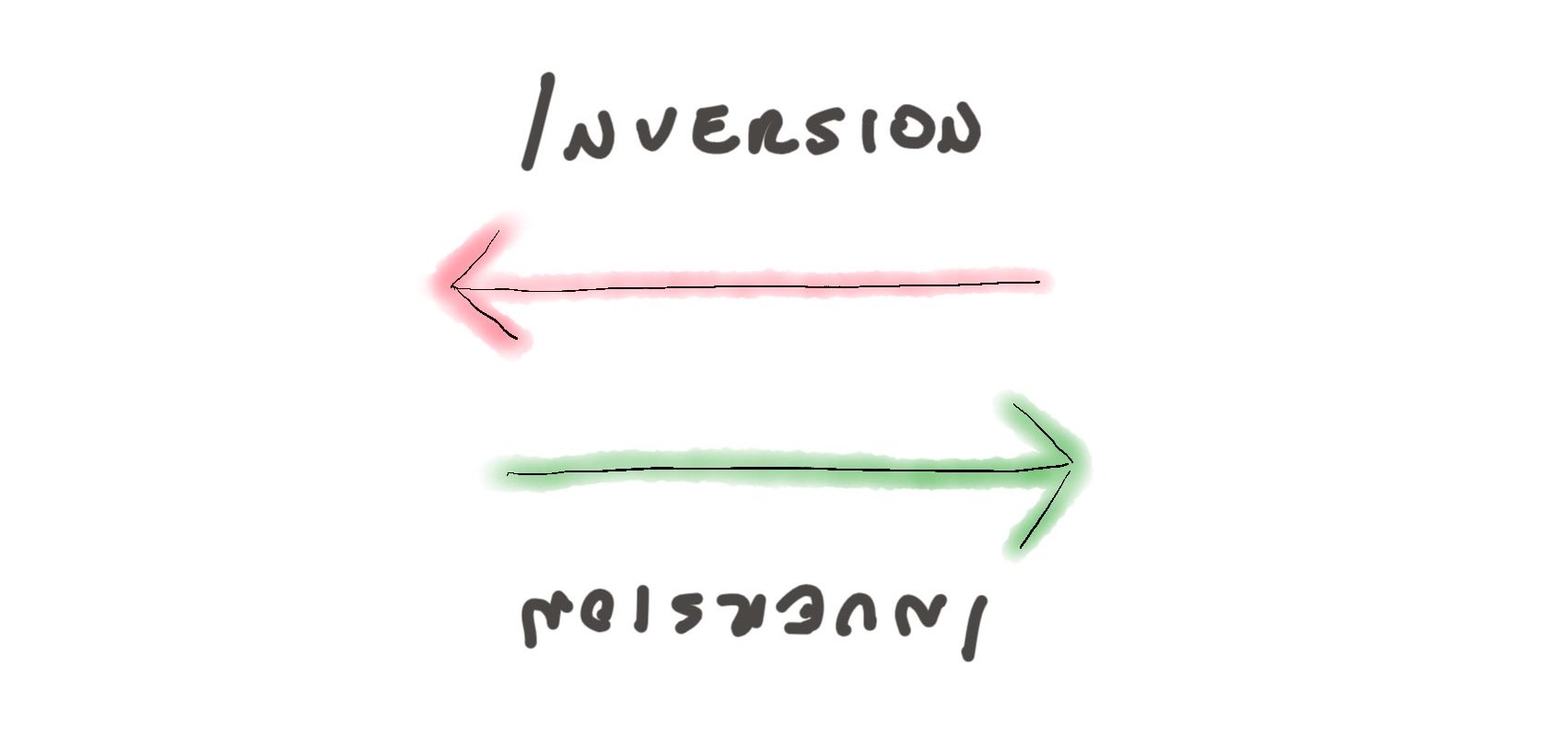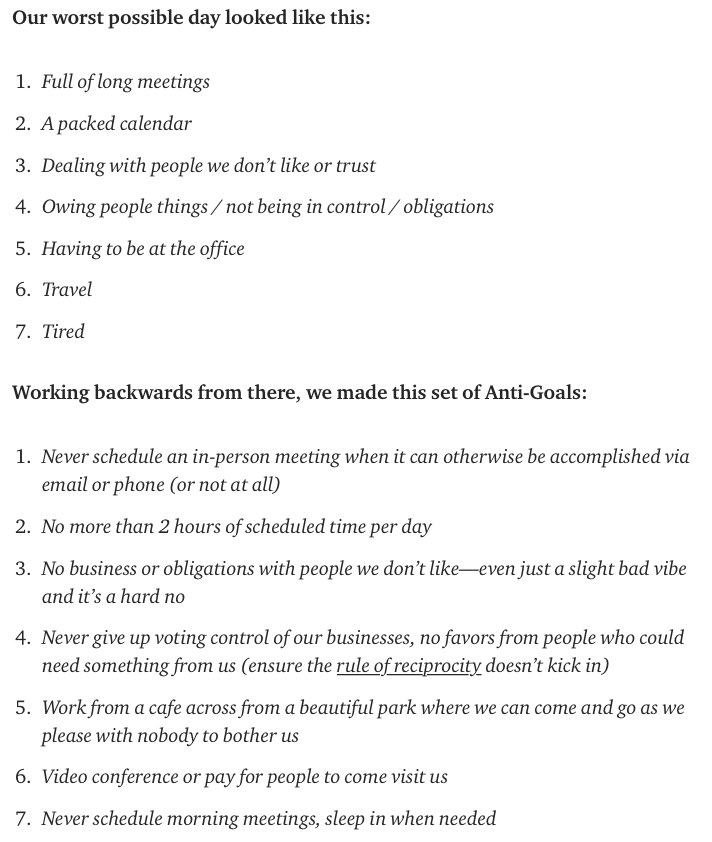Thread
I started establishing “Anti-Goals” for all new projects.
Everything changed.
Here’s how it works:
Everything changed.
Here’s how it works:
A few months ago, I came across the idea of “anti-goals” from my friend @awilkinson.
It quickly became a staple in my life.
I use the anti-goal framework to:
• Plan for new projects
• Design my life
• Create self-improvement plans
In this thread, I'll share how it works:
It quickly became a staple in my life.
I use the anti-goal framework to:
• Plan for new projects
• Design my life
• Create self-improvement plans
In this thread, I'll share how it works:
The concept is grounded in inversion—a foundational mental model that says that complex problems are often easier solved backwards vs. forwards.
Inversion was made famous by one quote:
“All I want to know is where I’m going to die, so I’ll never go there." - Charlie Munger
Inversion was made famous by one quote:
“All I want to know is where I’m going to die, so I’ll never go there." - Charlie Munger
With traditional goals, we envision the optimal outcome.
We then build systems that will—hopefully—lead to that outcome.
This is important and still necessary—but it’s incomplete.
Anti-goals leverage inversion to complete the picture.
We then build systems that will—hopefully—lead to that outcome.
This is important and still necessary—but it’s incomplete.
Anti-goals leverage inversion to complete the picture.
Anti-goals are the things we DON'T want to happen—either as final outcomes or along the way.
I think of anti-goals as being about avoiding the "Pyrrhic victory”—a victory that takes such a terrible toll on the victor that it might has well have been a defeat.
I think of anti-goals as being about avoiding the "Pyrrhic victory”—a victory that takes such a terrible toll on the victor that it might has well have been a defeat.
My friend @ShaanVP elaborates:
"Your dream was to be a musician. And you did it! But while touring the world, you gain weight, get addicted to drugs, and your kids don’t recognize you. You won the battle but lost the war."
Anti-goals are the key to avoiding these outcomes.
"Your dream was to be a musician. And you did it! But while touring the world, you gain weight, get addicted to drugs, and your kids don’t recognize you. You won the battle but lost the war."
Anti-goals are the key to avoiding these outcomes.
Ok, so how do you establish anti-goals?
My generalized process involves four steps:
(1) Choose Your Arena
(2) Establish Traditional Goals
(3) Invert the Problem
(4) Establish Anti-Goals
Let’s walk through each step:
My generalized process involves four steps:
(1) Choose Your Arena
(2) Establish Traditional Goals
(3) Invert the Problem
(4) Establish Anti-Goals
Let’s walk through each step:
Choose Your Arena
The arena is the "project" you’re going to be working on.
A few broad categories:
• Personal
• Work
• Health
Your arena should be a specific project under a larger category.
It’s the place where you’re looking for achievement, progress, or growth.
The arena is the "project" you’re going to be working on.
A few broad categories:
• Personal
• Work
• Health
Your arena should be a specific project under a larger category.
It’s the place where you’re looking for achievement, progress, or growth.
Establish Traditional Goals
These are your standard goals—the desired outcomes from the chosen arena.
A few examples:
• Run a 6-min mile
• Build a 100,000 sub newsletter
• Promotion to VP
• Create a top-25 podcast
Clear, big picture traditional goals are important.
These are your standard goals—the desired outcomes from the chosen arena.
A few examples:
• Run a 6-min mile
• Build a 100,000 sub newsletter
• Promotion to VP
• Create a top-25 podcast
Clear, big picture traditional goals are important.
Invert the Problem
Ask and answer a few questions.
In the pursuit of these goals:
• What’s the worst possible outcome?
• What systems would lead to that?
• What daily actions would I regret?
In short, what would you view as winning the battle but losing the war?
Ask and answer a few questions.
In the pursuit of these goals:
• What’s the worst possible outcome?
• What systems would lead to that?
• What daily actions would I regret?
In short, what would you view as winning the battle but losing the war?
Establish Anti-Goals
Now work backwards to establish your anti-goals.
Expanding on a @JamesClear analogy:
If traditional goals are the rudders that set your direction, think of anti-goals as the map that tells you where the rapids are.
Awareness keeps you on smooth waters.
Now work backwards to establish your anti-goals.
Expanding on a @JamesClear analogy:
If traditional goals are the rudders that set your direction, think of anti-goals as the map that tells you where the rapids are.
Awareness keeps you on smooth waters.
It can be a bit confusing in the abstract, so let’s look at a recent example from my own life:
The Arena: Physical Fitness
Traditional Goals:
• Run a 6-minute mile
• Under 8% bodyfat
• Deadlift 500 pounds
Perhaps overly-ambitious at 31, but I think doable if I’m dedicated!
The Arena: Physical Fitness
Traditional Goals:
• Run a 6-minute mile
• Under 8% bodyfat
• Deadlift 500 pounds
Perhaps overly-ambitious at 31, but I think doable if I’m dedicated!
Invert the Problem:
What does the worst possible outcome look like?
Letting it consume my entire life!
Constantly stressing about what workouts to do and about what foods to eat.
Working out for 3 hours per day when I want to spend time with my family and friends.
What does the worst possible outcome look like?
Letting it consume my entire life!
Constantly stressing about what workouts to do and about what foods to eat.
Working out for 3 hours per day when I want to spend time with my family and friends.
Breaking it down, what actions or systems would lead to that worst possible outcome?
Trying to do everything myself!
Managing my own research on workouts and food.
Trying to write, track, and manage my own workout and diet plan.
Not scheduling fixed windows for workouts.
Trying to do everything myself!
Managing my own research on workouts and food.
Trying to write, track, and manage my own workout and diet plan.
Not scheduling fixed windows for workouts.
Establish Anti-Goals:
(1) Never think about workouts. Hire a trainer to write workout programs.
(2) Never think about diet. Buy pre-prepared healthy meals.
(3) Never let workouts consume my life. Schedule 90-minute blocks at the same time every AM as my workout window.
(1) Never think about workouts. Hire a trainer to write workout programs.
(2) Never think about diet. Buy pre-prepared healthy meals.
(3) Never let workouts consume my life. Schedule 90-minute blocks at the same time every AM as my workout window.
My fitness project now has a complete picture:
Traditional Goals:
• Run a 6-minute mile
• Under 8% bodyfat
• Deadlift 500 pounds
Anti-Goals:
• Never think about workouts—hire trainer.
• Never think about diet—buy meals.
• Never let workouts consume life—schedule blocks.
Traditional Goals:
• Run a 6-minute mile
• Under 8% bodyfat
• Deadlift 500 pounds
Anti-Goals:
• Never think about workouts—hire trainer.
• Never think about diet—buy meals.
• Never let workouts consume life—schedule blocks.
In his original blog post, @awilkinson has a great example of using anti-goals to design his work.
He wanted to pursue success and wealth creation, but not at the expense of his peace of mind.
Establishing anti-goals to sit alongside his goals allowed him to do both.
He wanted to pursue success and wealth creation, but not at the expense of his peace of mind.
Establishing anti-goals to sit alongside his goals allowed him to do both.
To summarize the Anti-Goal Framework:
(1) Choose Your Arena
(2) Establish Traditional Goals
(3) Invert the Problem
(4) Establish Anti-Goals
So as you take on your next project, establish anti-goals to sit alongside your traditional goals.
Win the battle AND the war!
(1) Choose Your Arena
(2) Establish Traditional Goals
(3) Invert the Problem
(4) Establish Anti-Goals
So as you take on your next project, establish anti-goals to sit alongside your traditional goals.
Win the battle AND the war!
Follow me @SahilBloom for more threads on business, growth, and more.
If you enjoyed this, I will write a deep-dive on this topic in my newsletter in the weeks ahead. Join the 92,000+ others who will receive it straight to their inbox. sahilbloom.substack.com
If you enjoyed this, I will write a deep-dive on this topic in my newsletter in the weeks ahead. Join the 92,000+ others who will receive it straight to their inbox. sahilbloom.substack.com
And be sure to check out our podcast, where we go deep on many of these topics.
We have an upcoming episode with @awilkinson—it’s going to be a great one! podcasts.apple.com/us/podcast/where-it-happens/id1593424985?i=1000560738064
We have an upcoming episode with @awilkinson—it’s going to be a great one! podcasts.apple.com/us/podcast/where-it-happens/id1593424985?i=1000560738064


